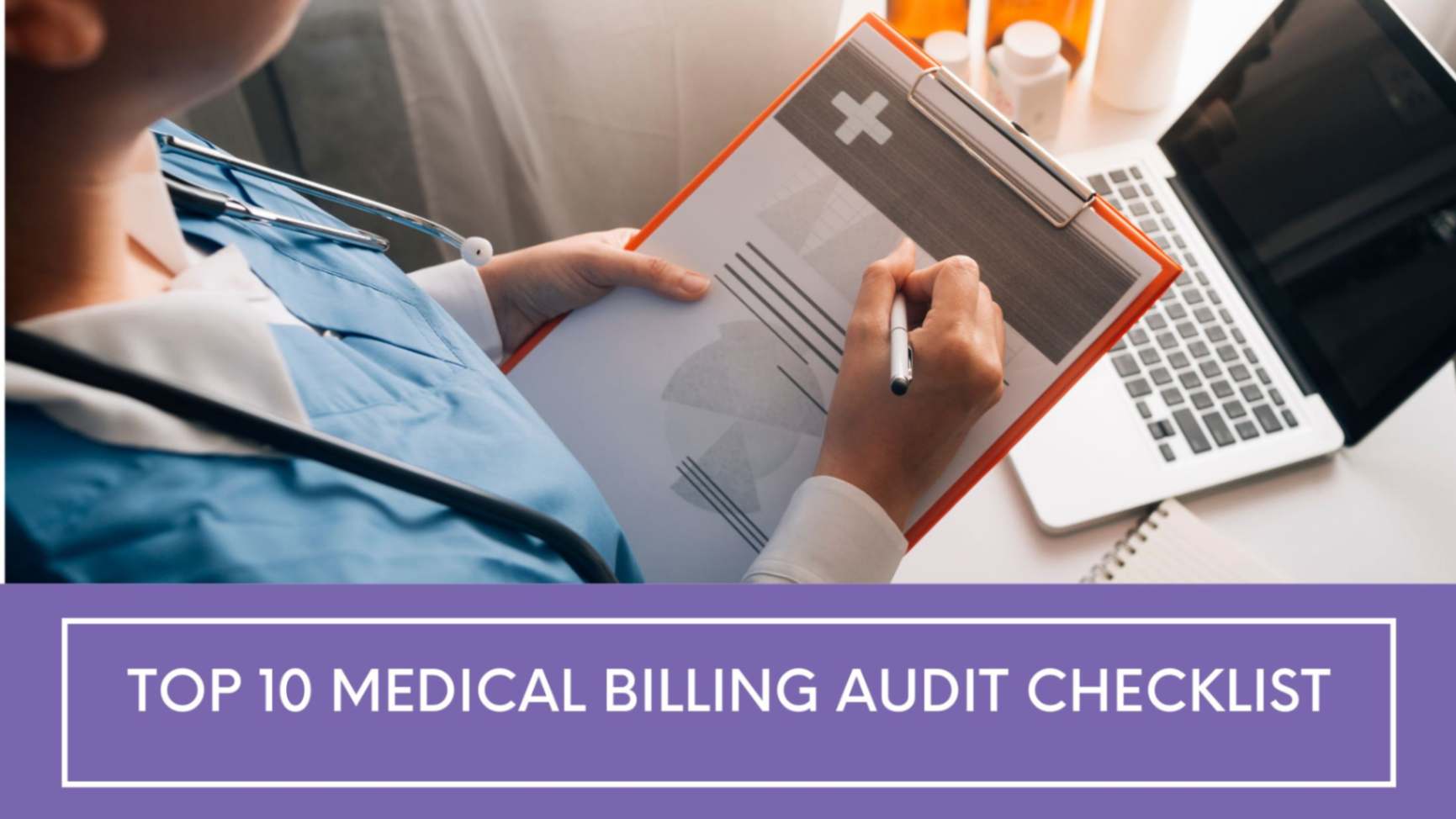Top 10 Medical Billing Audit Checklist
A medical billing audit is an organized evaluation of compliance and quality at a healthcare facility. Every aspect of running a practice is included in the audit process, but the most significant component in the medical billing audit checklist is the process leading to reimbursement. Every step leading to billing a claim is looked into for compliance with the federal and state guidelines, along with the regulations of the private insurance companies.
Medical billing audit aims to survive the ongoing scrutiny by insurance contractors and federal auditors. Implementing scheduled audits at the healthcare facility is the best defense against federal and insurance company audits. Any questionable billing patterns can be identified by auditing the claim data and generating risk reports so that healthcare facilities can identify their compliance oversights. Otherwise, such errors can cost the physician heavily in terms of federal prosecution, monetary penalties, criminal penalties, exclusion from insurance networks, and demands for payback of reimbursements.
Expectations from the medical billing audit are to ensure good quality patient care at the facilities and providers are educated on documentation on guidelines. A professional billing audit checklist can completely screen the revenue cycle management at the facility and optimize it to make sure appropriate payment is received per treatment. It also empowers you to defend against malpractice litigations, health plan denials, and audits from the state and private insurance companies.
Practolytics can help you in identifying the specific scope of a medical billing audit company, using the appropriate tools to performs the audit, adhering to a medical billing audit checklist, reporting the findings of the audit, and providing ideas to correct the errors and educate the staff. By conducting a successful audit, the auditors at Practolytics can help you resolve an ongoing non-compliant billing process at the facility. This would enable you and your team to safeguard your patients, receive the appropriate reimbursements and avoid risking payment litigations.
It helps to have a comprehensive medical billing audit checklist to not omit any crucial areas while auditing your practice. It is advised to fabricate a customized checklist based on the speciality needs of your practice. The list below is an overview of auditing any type of healthcare service. Let us look at each entry in the checklist in detail:
1. Verification of patient records
While preparing top 10 medical billing audit checklist, you must include verification of patient IDs and authorizations. The details such as name, date of birth, date of visit, date of service, place of service etc. recorded on the demographics chart have to be verified and cross-matched with claim documents.
Also, it is very important to verify whether the insurance coverage plan of the patient was active and valid for the date of service mentioned in the records. It should be strictly verified that the specified claim demographics and data is the same as that of the patient mentioned in the medical billing services; accidental switches in the names happens sometimes.
2. Verification of provider information
Details of the provider who issued the bills as well as the provider who rendered the service should be looked into. It is very crucial to make sure the provider listed in the documentation is duly licensed and credentialed as per the norms of the state. Check the document if they are properly signed and authorized, wherever required, by the right provider.
3. Investigate for duplicate records attached by mistake
Additional details to be verified are whether there is a history of paid or denied claims from this healthcare provider on the same date of service, codes and bills. What codes were paid and what were denied in the previous claims, and whether the records submitted in the previous claim were the same as the current one or additional records were present—all this needs to be confirmed. Has that provider split the bills of service for the same date of service into more than one claim? Such things must be scrutinized in the audit.
Also Read – In-house Medical Billing vs. Outsourced RCM
4. Verification of the electronic health records (EHR)
According to the medical claims audit process, cross-match the IDs in all records, verify if the correct dates are entered for all visits and procedures, look for clarity and completeness of information, verify if past medical history is recorded appropriately, check if it includes data on allergies, adverse reactions, drug and food interactions, smoking, alcoholism and substance abuse etc.
5.Completeness of medical history and physical visits
Verify whether the correct chronology is maintained in all the documents on patient encounters, physician examination and follow-up visits. Medical billing checklists stress legible and detailed entries on all of the findings by primary care physician—complete with all the health problems enumerated by the patient listed.
Every detail from referrals to other departments should be there and checked if the documented records exhibit continuity and coordination of services provided by primary physicians and speciality providers. The date of service and provider information on speciality consults, along with the summary of the visit, should be enclosed.
6. Verification of diagnostic reports
Orders for blood works, radiological examinations etc. are to be documented and verified if they are appropriate for the suspected disease conditions. The radiological reports should be completed with the interpretation of the image included and duly authorized by the provider who interpreted the result, according to the medical billing audit checklist. All lab results should be complete with appropriate dates and authorizations by authorities.
7. Completeness of diagnosis and treatment plan
Details of final diagnosis and disease condition are the pivot of the medical billing audit checklist since they form the base for the treatment plan. It is crucial to investigate whether the treatment plans were consistent with the diagnoses, and if the summary reports from the speciality consultants, lab reports, imaging and scan reports were recorded along with the other documents. These should match the primary care physician’s findings to make sure everything is in order.
8. Details of the procedures conducted
Every record on date and type of procedures conducted, information on the provider, material list and quantities used for the procedure are to be looked into. The medical billing audit checklist demands details on informed consent noted down and authorized by the patient, by-stander and the appropriate provider without fail. It should be checked whether the documents are enclosed with complete immunization records of the patient and details on all missed or cancelled appointments previously scheduled are included.
9. Documents on prescribed medications
Documents should contain all records on drug prescriptions and refills. In case a medical device was prescribed for the patient as part of the treatment, verify if there is a complete valid prescription from the ordering physician included among the medical records. Medication datasheets, properly allocated as per the department and provider issuing the prescription, should be enclosed too. It should be confirmed that there is enough documentation on patient education and follow-up instructions provided post-procedure.
Also Read – Role of medical billing software in RCM services
10. Verification of codes assigned and formats used
For those who are wondering what are medical billing checklists, coding compliance verification of billing documents is the most integral part of it. There are numerous specifics to be scrutinized regarding coding. Always check if the right CPT/ICD codes are used on the claim. Also, verify whether the codes assigned in the claim align with electronic health reports and the applied diagnostic codes are of the highest possible specificity based on the medical documentation.
Verification of the coding process is the most crucial component of the medical billing audit checklist. Appropriate use of modifiers in coding needs to be evaluated and also, whether the number of units billed is correct, with appropriate codes for a single unit or multiple units. Make sure that the right procedural codes and ancillary service codes are used by the medical billing services involved. Also, look at whether potential risk factors like unlisted codes, miscoding, unbundling of services and upcoding etc. were conducted during the process. Always cross-check the bills with codes assigned and check if the billing document meets the payer criteria.
All the queries in the medical billing audit checklist must be correctly answered for the successful completion of the process. The above-mentioned medical billing checklist for claims is a set of pointers to improve your billing policies, efficiency and effectiveness of documentation and profitability at the practice.
At Practolytics, we are equipped with the right tools and expert auditors to dig into the core of your billing process and churn out the risk factors. With the help of smart software and professional auditors, Practolytics can empower you to eliminate all the pitfalls in practice that might cost you big in terms of financial loss and legal menaces.
Join us today to troubleshoot the frequent deficiencies in reimbursement and make sure to earn your cut.
Also Read – Top Mistakes in Credentialing Process that Cause Revenue Loss for Medical Practices
Talk to Medical Billing Expert Today — Get a Free Demo Now!







